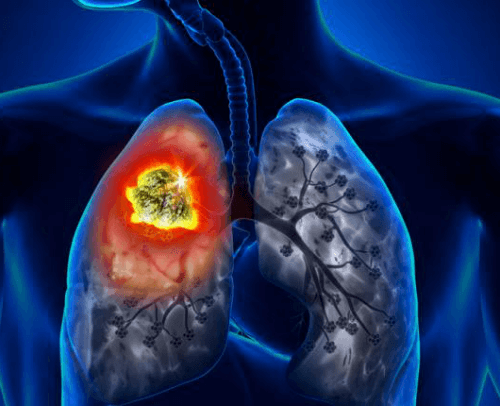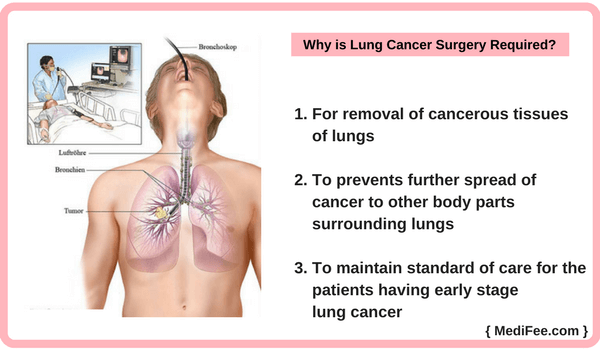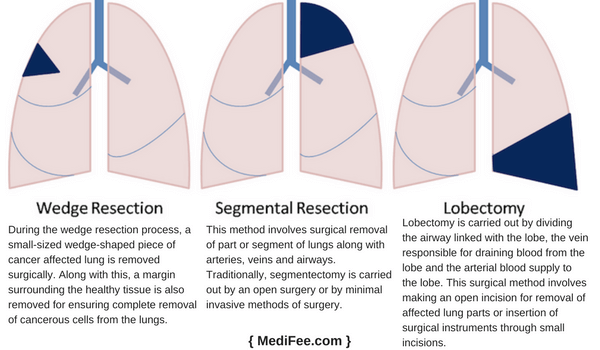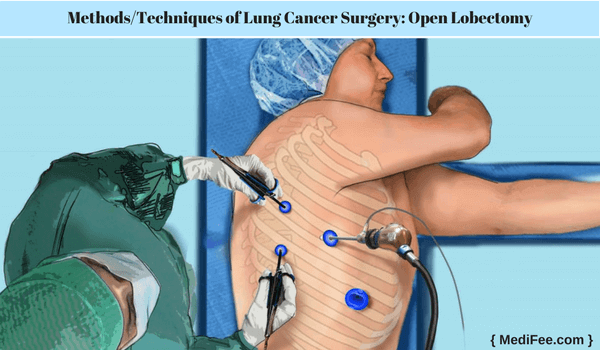Lung Cancer Surgery
Listed below is the step by step procedure of lung cancer surgery:
- What is Lung Cancer Surgery?
- Why is Lung Cancer Surgery Required?
- Pre-operative Preparation
- Day Before Surgery
- Procedure Day
- Methods/Techniques of Lung Cancer Surgery
- Post Procedure
- Risks and Complications
- FAQs
What is Lung Cancer Surgery?
Lung cancer is a serious disorder needing immediate care and treatment. Lung cancer surgery comprises of all surgical methods employed for eliminating this cancerous disorder from the patient's body.

Why is Lung Cancer Surgery Required?
After a patient has been diagnosed with lung cancer, the oncologist will proceed to choose treatment options which are best suited to the case. Chemotherapy, medicinal therapy, radiation therapy and surgery are the different types of treatment methods to eliminate cancer of lungs. Mostly, a combination of any of these can be sued to treat cancer. However, following are some indications of lung cancer which necessitate the use of surgery as the only way of treatment:

- Early diagnosis: If cancer gets diagnosed at a very early stage, the cancer tumor is relatively smaller and has invaded only a small area of the lungs. The remaining healthy portion of lungs can be salvaged if the diseased portion is removed by performing surgery.
- Failure to respond to other modes of treatment: If a patent of lung cancer fails to respond adequately to medicinal therapy, chemotherapy or radiation therapy, surgery can be considered as a way of treatment.
- In combination with other treatment methods: As mentioned earlier, any of the treatment methods can be used in combination with the others in order to eradicate lung cancer completely. Surgery can be used in combination with either radiation therapy or chemotherapy
Pre-operative Preparation
Surgery is always a well planned procedure and requires some preparation time. Following are some important pre-operative steps which should be taken in order to ensure a successful surgery.
- Discussion with doctor: Once the decision of opting for surgery is taken, an oncosurgeon will take over the case. The oncosurgeon will explain about the surgery in detail to the patient. All the precautions to be taken before and after surgery, recovery period, risks and side effects of surgery are discussed. If the patient agrees to all terms and conditions of the surgery, they are expected to provide with a signed consent stating that they are willing to undergo the procedure.
- Investigations: Prior to undergoing lung cancer surgery, certain investigative blood tests and scans are performed on the patient to rule out any other health conditions which might be an obstacle during surgery. Blood tests are done to determine levels of blood sugar, white blood cells, platelets. Kidney function and liver function are also checked via blood tests. These levels should be within normal limits prior to proceeding with surgery. X-Ray of the chest, or CT and MRI scan of the lungs provides the surgeon with an idea about the portion of lungs which needs to be removed. An ECG is done to determine cardiac activity. Lung function test may also be performed to check whether the lungs are able to perform respiratory functions properly or not.
- Medicines: Prior to the surgery, patients are provided with a prescription for certain pre-operative medications. Antacids are often prescribed prior to surgery to prevent development of acidity. If the patient is taking any medication for other disorders, the physician might alter the dosage of those medicines temporarily till the surgery is completed. If blood thinning medicines are being taken, even these could be stopped till surgery is over.
- Anesthesia: Lung cancer surgery will be performed under general anesthesia. The patient will be completely unconscious during surgery. The type of anesthetic medication to be used for surgery will be decided depending upon the patient's general health. Sometimes, allergic reaction could be developed to certain anesthetic agents. The oncosurgeon will determine whether the patient is allergic to any particular anesthetic agent and that agent is not used during surgery.
- Smoking and alcohol consumption: Smoking is strictly prohibited in patients who have been diagnosed with cancer surgery. If they still have not given up, it is advisable to completely stop smoking since few weeks before surgery. People who are habituated to drinking alcohol are advised to stop consuming any alcoholic drinks since a few weeks or days before surgery. These habits could be harmful for the patient during recovery from surgery.
Day Before Surgery
A day before surgery, the patient must make sure that they rest properly and avoid undue mental and physical stress. Sometimes the patient may be asked to get admitted to the hospital one night prior to surgery. The patient is advised to refrain from consuming any food from one night prior to surgery, till the surgery is over.
If patients are admitted to the hospital one night prior to surgery, their blood pressure, respiratory rate, heart beat and body temperature (vitals) will be monitored at set time intervals.
Procedure Day
On the day of surgery, patient is expected to arrive at the hospital well in advance for the surgery, if they have not been admitted a day before. They are offered a clean, sterile, loose, hospital gown to wear during surgery. Before the scheduled time of surgery, the patient is transferred from his/her room to the operation theater. There, the patient's vitals are examined again.
An anesthetic agent which was previously chosen for the surgery is administered to the patient via an injection in the vein, or via the nasal route in the form of inhalant. The patient's conscious levels are continuously monitored. The patient is positioned suitably so that the surgeon has a clear field of vision while operating. The skin over chest is cleaned with an antiseptic solution. All hair over the skin is shaved. A catheter is inserted into the bladder to facilitate passage of urine. Once the anesthetist confirms that the patient is completely under the effect of anesthesia, the surgery is started.
Methods/Techniques of Lung Cancer Surgery
The technique used to perform lung cancer surgery depends largely on the extent to which cancer has spread, the patient's age and their general health. Following are the commonly employed techniques of lung cancer surgery:
- Lobectomy
- Open Lobectomy
- Minimal Access Surgery
- Wedge resection
- Segmentectomy
- Pneumonectomy
- Surgical lymph node removal

Lobectomy
Each lung in the human body is comprised of lobes. The right lung has 3 lobes, and the left lung has 2 lobes. Lobectomy is a preferred procedure when cancer is localized to a specific region of the lung. While operating for lung cancer, the oncosurgeon might opt to remove the entire lobe corresponding to the cancerous region, rather than excision of only the cancerous portion. For lobectomy, the surgeon may use open method or thoracoscopic method:
- Open Lobectomy
The patient is turned to one side so that the side which is to be operated upon, faces the surgeon. A relatively large incision is created upon the skin over the chest, from the nipple to the shoulder blade. This gives a clear field of vision while operating. Next, the ribs covering the affected lung are separated using appropriate instruments.

The blood vessels and bronchus (respiratory tubes) connected to the diseased lobe are separated and secured. The lobe is separated from the other healthy lobe and removed. The ribs are returned to their former position and the skin incision is closed using medically designed thread.
- Minimal Access Surgery
The same procedure as open lobectomy is performed using a thoracoscope. Multiple smaller incisions are made on the skin over chest corresponding to the diseased lobe of the lung. The thoracoscope (an instrument equipped with a small camera attached to its end) is inserted into the chest cavity. This helps the surgeon to visualize all the internal organs clearly on a screen where all recordings from the camera are displayed. Surgical instruments are inserted through the other small incisions. The rest of the procedure is the same as is performed in open procedure. This procedure can also be done using automated mechanized robotic arms which are controlled by the oncosurgeon through a computerized panel. This procedure is known as robotic lobectomy.
When the right lung is affected with cancer and two lobes have to excised instead of only one, a similar procedure is required. It is known as bilobectomy.
Wedge resection
Like lobectomy, this procedure also can be employed only in cases where lung cancer is localized to a particular region. The procedure can be done by open or thorascopic method. Only a small wedge of the lung corresponding to the diseased part of the lung is removed as opposed to the entire lobe, which is done in lobectomy.
Segmentectomy
Segmentectomy involves removing a specific portion of that lobe of lung, which is cancer ridden. A segment is a part of the lung including bronchi, respiratory airways and blood vessels. Except for the amount of lung tissue to be removed, the procedure is similar to lobectomy. This procedure is preferred in patients who have a very limited amount of healthy lung tissue. Removing only a segment ensures that substantial healthy lung tissue is left behind to maintain the patient's respiratory capacity to optimum levels.
Pneumonectomy
This procedure entails removal of the entire lung, part or whole of which is affected by cancer. It is mostly an open procedure as a huge amount of tissue is to be excised. A long incision is made on the side corresponding to the cancerous lung. When the surgeon visualizesunderlying ribs, he exposes them or even separates them at times, to access the lung. All the air is cleared from the lung and the airway tubes and blood vessels connected to the lung are separated and tied off securely. The collapsed lung is then removed from the space made between adjacent ribs. The surgical incision is then sutured with a surgically designed thread.
Surgical lymph node removal
Cancer of any organ or body system easily spreads to the lymph nodes adjacent to the affected organ. Therefore, to prevent affection of lymph nodes and prevent further spread of cancer, it might sometimes be advisable to remove the lymph nodes surrounding the cancerous lung. This surgery can be done by open or minimal access method. It is usually done in association with lobectomy, wedge resection, pneumonectomy or segmentectomy.
During all the above mentioned surgeries, an endotracheal tube is placed within the person's trachea to maintain respiration.Post Procedure
After completion of surgery, when patients gain consciousness, they may experience drowsiness. Some tubes such as IV infusion for fluid may be attached to the body of the patients. The patients will be kept in an intensive care unit (ICU) immediately after surgery for sometime after surgery.
- Recovery at Hospital
After the surgery, the patient is kept in the hospital for 2-4 days. The patient will be examined after regaining consciousness. The surgical incision is covered with soft cotton and bandage. The patient is encouraged to move around but exertion is to be avoided. Movement stimulates healthy blood circulation which helps faster recovery. Antibiotics and pain killer medications are started to prevent pain and infection.
- Recovery at Home
After discharge from hospital, the patient is given certain care instructions which they should follow for avoiding complications after surgery. It is important to take care of the surgical wound. It should be kept clean and dry. All medicines prescribed by the surgeon are advised to be taken regularly. The patient should be mobile at home and not remain lying down in one place. But it is not advisable to venture out of the house. This would increase chances of contacting respiratory infection which could lead to complications.
- Follow-up
The surgeon will give a follow-up schedule to the patient. Regular check ups help in assessing the recovery rate and general health of the patient. If patients experience any difficulty related to their health, they can discuss it with their doctor during the follow-up. The surgical incision is examined during each follow-up. The stitches will be removed after the incision has healed completely.
- Physiotherapy
Physiotherapy is as useful in respiratory disorders as it is in case of joint troubles. A physiotherapist may be consulted if patient is having difficulty in breathing after surgery. This could occur if the entire cancerous lung is removed. Exercises to improve efficiency of respiratory muscles will help the patient.
- Investigations
Regular blood tests, CT scan or MRI scan or X-Rays are usually advised to patients at regular intervals to monitor the their health. These investigations will help the surgeon to assess whether the patient's cancer has resolved completely or whether it is recurring in the lungs or any other organ.
Risks and Complications
- Pain: Severe pain can be experienced in some patients of lung cancer for a long time after surgery. Such pain can be a result of damaged nerves during the surgical process. In some patients, this pain gradually reduces, while in some cases it persists. If the pain does not subside considerably with medication, then it is advised to consult with a pain medicine specialist.
- Organ damage: While performing lung cancer surgery, it is likely that adjacent healthy portion of the lungs, or other healthy organs, nerves and blood vessels may suffer from accidental injury. Depending on the extent of injury, corrective treatment may be started to restore normal functions of the damaged organ.
- Respiratory difficulties: After removal of part or the whole of lung, it is natural to experience respiratory difficulties. Patients can benefit a lot with regular respiratory physiotherapy and yoga. Exercises which enhance the ability of respiratory muscles can help patients considerably.
FAQs
- Is it possible for patients of lung cancer to breathe properly post-surgery?
A. It is a concern in many cases when there is removal of one lobe of lung during lung cancer surgery. Though one lobe of lung is removed, no breathing problems have been reported in most of the cases. One can breath in normal way. Patients suffering from breathing problems prior to surgery may continue to suffer from the same post surgery.
- How can one help get over the lung cancer surgery?
A. After surgery, it is highly advised to follow healthy lifestyle including healthy diet and exercise. This helps in early recovery. Family members can also help patients of cancer to recover faster with proper care and moral support. Following all instructions of your surgeon is the key to fast recovery.
More information related to Lung Cancer Surgery
List of the best oncology surgeons in India and top cities
List of the best pulmonology hospitals in India

